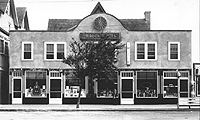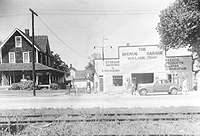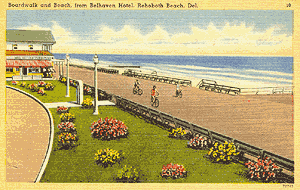 In 1872, the Reverend Robert W. Todd, of St. Paul's M. E. Church in Wilmington, being very feeble from weeks of camp meeting services, visited Ocean Grove Camp Meeting on the Jersey Shore. Returning to St. Paul's, greatly restored in health and spirit, he told of his experiences in a sermon, using as his text the words, "And the sea hath spoken."
In 1872, the Reverend Robert W. Todd, of St. Paul's M. E. Church in Wilmington, being very feeble from weeks of camp meeting services, visited Ocean Grove Camp Meeting on the Jersey Shore. Returning to St. Paul's, greatly restored in health and spirit, he told of his experiences in a sermon, using as his text the words, "And the sea hath spoken."
Soon he found himself inspired and consumed with the idea of having a Christian sea-side resort for this Peninsula, and regions adjoining and beyond; thus, it must be on the sea coast somewhere between Cape Henlopen at the mouth of the Delaware Bay and Cape Charles at the mouth of the Chesapeake Bay. Rev. Todd knew that some years earlier there had been an effort made to establish a "watering place" near Rehoboth Bay along what is now Dewey Beach, so he began to look for land in that neighborhood which would be suitable for his purpose. His obsession with this desire to establish a camp meeting resort became so intense that his waking thoughts were transferred to the region of DREAMS; and, WHILE SLEEPING, he "visited" the location (afterwards purchased as it was suited to his purpose). Strange as it may seem, when he actually visited the site Nederlandsegokken NL casino online website, the topography he found along the sea shore corresponded exactly with that "seen" in his dream, even though his dream site proved to be a mile north of the Rehoboth Bay area. So it came to be that, on January 27, 1873, "The Rehoboth Beach Camp Meeting Association of the Methodist Episcopal Church" established its grounds here with the intended purpose of presenting religious "camp meetings" in the summer months. The grounds of the Camp Meeting Association extended to the town which was laid out in a fan shape design with wide streets, parks and spacious lots. These land plats were recorded in Georgetown and so marked the "Birth of Rehoboth." The name, of course, had been taken from Rehoboth Bay which had been so named in the 17th century by early English explorers from the Virginia colony, while searching for a passage west. The unknown Captain who discovered the bay took the name from the Bible, Genesis, XXVI: 22. (In early Hebrew, Rehoboth meant "broad places.")
His obsession with this desire to establish a camp meeting resort became so intense that his waking thoughts were transferred to the region of DREAMS; and, WHILE SLEEPING, he "visited" the location (afterwards purchased as it was suited to his purpose). Strange as it may seem, when he actually visited the site Nederlandsegokken NL casino online website, the topography he found along the sea shore corresponded exactly with that "seen" in his dream, even though his dream site proved to be a mile north of the Rehoboth Bay area. So it came to be that, on January 27, 1873, "The Rehoboth Beach Camp Meeting Association of the Methodist Episcopal Church" established its grounds here with the intended purpose of presenting religious "camp meetings" in the summer months. The grounds of the Camp Meeting Association extended to the town which was laid out in a fan shape design with wide streets, parks and spacious lots. These land plats were recorded in Georgetown and so marked the "Birth of Rehoboth." The name, of course, had been taken from Rehoboth Bay which had been so named in the 17th century by early English explorers from the Virginia colony, while searching for a passage west. The unknown Captain who discovered the bay took the name from the Bible, Genesis, XXVI: 22. (In early Hebrew, Rehoboth meant "broad places.")
Small, one room wooden structures called "tents" were constructed on the encampment grounds, situated first on the western end of Rehoboth Avenue, where they surrounded a center structure known as "the tabernacle." With the coming of the railroad, the camp meeting site moved eastward to Baltimore Avenue. The Anna Hazzard Museum, though modified, is one of the camp meeting tents dating from the 1890's and originally located on lot #38 (59 Baltimore Avenue). It was acquired by Mr. William H. White of Lewes in 1895 and conveyed to his niece, Miss Anna Hazzard (1878-1968) in 1927.
When Miss Hazzard was in her teens, she assisted Mr. White in his real estate business in Rehoboth. As a result of that experience, she became the first woman real estate broker in the town. Upon her death, the tent was inherited by Mr. and Mrs. Ronald James. In 1975 Mayor Miriam E. Howard arranged for the donation of the tent house to the city. It was moved from Baltimore Avenue to Christian Street. After some restoration, it was dedicated in October of 1976. Since that time, the Rehoboth Beach Historical Society has been charged by the City of Rehoboth Beach with the operation of the Museum in accordance with a mutual agreement.
